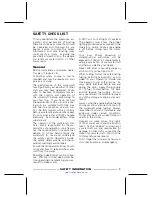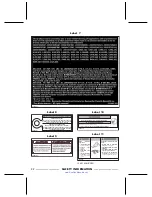
OPERATION
Collision Avoidance
Do not release throttle when trying to
steer away from objects. You need
throttle to steer.
Always keep a constant lookout for
other water users, other boats or ob-
jects, especially when turning.
Be
alert for conditions that may limit your
visibility or block your vision of others.
Respect the rights of other recreation-
ists and/or bystanders and always
keep a safe distance from all other
craft, people and objects.
Do not wake or wave jump, ride the
surf line or attempt to spray or splash
others with your watercraft. You may
misjudge the ability of the watercraft
or your own riding skills and strike a
boat or person.
This watercraft has the capability of
turning more sharply than other boats,
however, unless in an emergency, do
not negotiate sharp, high speed turns.
Such maneuvers make it hard for oth-
ers to avoid you or understand where
you are going. Also, you could be
thrown from the watercraft.
Like any other craft, this PWC has no
brake. Stopping distance will vary de-
pending on initial speed, load, wind,
and water conditions. Practice stop-
ping and docking in a safe, traffic free
area to have an idea of how long it will
take to stop the watercraft under vary-
ing conditions.
Maintaining or increasing speed may
be necessary to avoid a collision.
Safe Riding
Always keep in mind that as the throt-
tle lever is released to idle position,
less directional control is available, and
as the engine is off, directional control
is lost. You need throttle to steer.
Ride within your limits and level of
riding ability. Avoid aggressive ma-
neuvers to reduce the risk of loss of
control, ejection and collision. Under-
stand and respect the performance or
your watercraft.
Always ride responsibly and safely.
Use common sense and courtesy.
While your watercraft has the ca-
pacity of operating at high speeds, it
is strongly recommended that high
speed operation only be applied when
ideal conditions exist and are permit-
ted. Higher speed operation requires
a higher degree of skill and increases
the risk of severe injuries.
The forces generated on the body
of riders while turning, negotiating
waves or wakes, operating in choppy
waters, or falling off the watercraft,
especially at higher speeds,
may
cause injury including the possibil-
ity of broken legs and other bones or
more serious injuries. Remain flexible
and avoid sharp turns.
Do not engage in stunts or jumps as
they could lead to serious injuries or
even death. For example, you could
hurt your back in landing from a jump
or you could loose control of the wa-
tercraft while attempting to perform a
stunt, and collide with your own wa-
tercraft or another obstacle. This wa-
tercraft offers many riding configura-
tions, and it is important that, for your
safety, you strictly follow the instruc-
tions on proper use of the watercraft in
each configuration as they ensure that
your riding position allows you to re-
main in control of the watercraft at all
times. Any riding position that is not
explicitaly recommended by the man-
ufacturer could lead to a loss of con-
trol and potentially serious injuries or
death.
14
___________
SAFETY INFORMATION
___________
www.SeaDooManuals.net
Содержание 2004 3D RFI
Страница 1: ...C M Y CM MY CY CMY K www SeaDooManuals net ...
Страница 8: ...SAFETY INFORMATION ____________ SAFETY INFORMATION ____________ 7 www SeaDooManuals net ...
Страница 25: ...VEHICLE INFORMATION _____________________ 25 www SeaDooManuals net ...
Страница 70: ...MAINTENANCE INFORMATION _____________________ 71 www SeaDooManuals net ...
Страница 101: ...WARRANTY _____________________ 103 www SeaDooManuals net ...
Страница 118: ...C M Y CM MY CY CMY K www SeaDooManuals net ...
















































